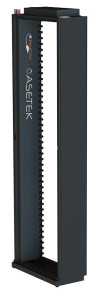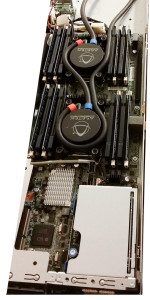The University of Tromso (UiT) the “Artic University of Norway” is the world’s northernmost university with four campuses spread out across Norway. UiT is already a leader in High Performance Computing (HPC). In 2007 its STALLO cluster became the most powerful cluster in Norway and reached 63rd position in the Top500. In 2014 STALLO 2 is expected to reach 310 Teraflop in peak performance.
UiT’s innovative thinking includes using supercomputing clusters as a heating plant. Specifically, the waste heat from the High Performance Computing facility is the energy source for building and district heating, reducing overall campus energy demand.
“Recently we have moved our attention from counting how many flops we can get out of the supercomputer to how many watts that can be recycled from the same computer” says Svenn Hanssen, Head of Section Research and Educational IT, University of Tromso
UiT believes that hot water cooling is something that gives the Arctic region an advantage and positions the region as a natural place to establish future datacenters. With an average temperature of 4ºC, UiT is an ideal location for re-use of waste heat from data centers. By cutting millions of krones from the power bill, more money can be spent on computing, software and the actual research. Waste heat recovery is also key in UiT’s goal to become the world’s leader in Green HPC.
During the summer of 2014 UiT will complete the build of a new 2MW data center. Its supercomputing cluster is expected to be around 2/3rds cooled by hot water with the longer term goal to make the entire cluster water cooled. The system will use the exit water from cooling the supercomputer as a heat source for the nearby buildings that will expand in the next phase to also provide heat to the hospital next door. The hot water will be used to heat the structures via both wall and ceiling radiators.
UiT began installing Asetek’s RackCDU D2C™ hot water data center liquid cooling in January 2014with the goal of using the supercomputing cluster as a district heat plant. The RackCDU D2C system consists of two key sub systems: D2C™ server coolers that are drop in replacements for the CPU air heat sinks in each server and a RackCDU extension that mounts of the back of each rack. Asetek D2C server coolers bring low-pressure, hot water inside the computing nodes to directly cool high heat flux components such as CPUs, GPUs and memory.
The RackCDU Extension is a 263mm (10.5 inch) cabinet that contains a zero-U rack level Cooling Distribution Unit (hence RackCDU) that exchanges heat between the cooling liquid running through the servers and the liquid in the larger facilities liquid cooling / waste heat recovery loop. Hot cooling liquid moves  between RackCDU and server coolers via tubes that attach with dripless quick connectors to the RackCDU and via blind mate connectors to the server coolers. The server cooler, connecting tubes and RackCDU are all delivered pre-filled with coolant. Data center operators never have to deal with server cooling liquid.
between RackCDU and server coolers via tubes that attach with dripless quick connectors to the RackCDU and via blind mate connectors to the server coolers. The server cooler, connecting tubes and RackCDU are all delivered pre-filled with coolant. Data center operators never have to deal with server cooling liquid.
RackCDU enables much higher rack densities, reduces the overhead power requirements for data center cooling, lowers acoustic noise and enables the use of waste heat to be recouped for building and district heating.
Hot water cooling is highly effective since the surface temperature of a CPU (case temp) only needs to be maintained between 67°C to 85°C (153°F to 185°F), depending on CPU model. The operating surface temperatures for memory chips, GPUs and co-processors is even higher, in the 90°to 95°C (194°F to 203°F) range. The cooling efficiency of water allows it to maintain the required case temps with a low initial temperature difference between the water and the component being cooled, or a small delta T. This means the water used for cooling the components can be hot. RackCDU D2C is deployable as part of completely new clusters, in server refresh cycles or even as retrofits of existing servers. In particular, there is the ability to implement D2C in many standard air cooled servers offered by OEMs today just as UiT is doing with its HP SL230 servers.
UiT chose to concentrate on D2C cooling of CPUs in the HP SL230 servers used in their HPC cluster. Air-cooled HP SL230’s are a popular choice in the HPC world and RackCDU D2C allows the leveraging these cost-effective nodes to run more efficiently through liquid cooling while enabling high density deployments and substantial power savings.
To make best use of the waste heat a number of factors must be optimized. UiT is manipulating a range of parameters for optimization: flow rates, amount of hot water needed, the temperature of the water, the delta between the supply and return temperature and the size of the supercomputer in terms of possible production of hot water.
Initial testing has shown it is possible to achieve that greater than 70% waste heat recycling with a delta of 25oC between input and exit temperature of the cooling water. The testing to date has been with a rather cold 12oC supply temperature and performance is expected to be even better at higher input temps. Air temperature in the computer room is also a factor. UiT has found that as they increase the room temperature, the water cooled system performance is not affected. Conversely, the air cooled systems start to spend more power for cooling as room temperature rises.
to date has been with a rather cold 12oC supply temperature and performance is expected to be even better at higher input temps. Air temperature in the computer room is also a factor. UiT has found that as they increase the room temperature, the water cooled system performance is not affected. Conversely, the air cooled systems start to spend more power for cooling as room temperature rises.
Because it is an HPC computing cluster, a 100% server load is common. The UiT load is typically greater than 80% 24 hours per day/7 days a week, making it ideal for heat capture and reuse.
One of the side effects of moving to hot water cooling and implementing district heating at UiT is the shift in how the supercomputing resource is viewed. No longer is the supercomputer seen as a multi-million dollar yearly expenditure in terms of variable power costs. It is now actually something the whole university expects to be expanded and integrated into the infrastructure to provide heating as well as power cost savings. Indeed, the visibility has built such enthusiasm that there are even artists trying to hook the supercomputer up to new art installations on campus to give different perspectives to the artwork based on the real-time load of the system.
UiT’s leadership in supercomputing is being matched by its mission to become the world’s leader in green High Performance Computing. Not only greening the data center itself but in recouping energy for district heating and having the supercomputing cluster be viewed as a community asset.




























































